Network Pharmacology Investigation in the Mechanism of Radix Pseudostellariae-Rhizoma Anemarrhenae Therapy for Diabetes Mellitus
2020-04-20ZHANGJiawen张嘉文CHENXinyan陈欣燕ZHOUMengqi周梦琪LINYanzhao林嬿钊YANGZhimin杨志敏
ZHANG Jia-wen (张嘉文), CHEN Xin-yan (陈欣燕), ZHOU Meng-qi (周梦琪),LIN Yan-zhao (林嬿钊), YANG Zhi-min (杨志敏)
1. Preventive Treatment Center of Guangdong Province Traditional Chinese Medical Hospital, Guangzhou 510120, China
2. Dongzhimen Hospital, Beijing University of Chinese Medicine, Beijing 100700, China
ABSTRA CT Objective:To explore the targets and signaling pathways of Radix Pseudostellariae-Rhizoma Anemarrhenae treating diabetes mellitus by network pharmacology and expound its mechanism.Methods:The TCMSP and SymMap databases were used to screen out the active ingredients and targets of Radix Pseudostellariae-Rhizoma Anemarrhenae. The GenCards database was used to screen the predicted targets of diabetes mellitus. Two targets were mapped. The Cytoscape 3.7.2 software was used to construct the network diagram of Chinese medicine-active ingredient-target and screen out the core ingredient and target. The GO,KEGG pathway enrichment analysis was carried out by OmicShare and David.Results:According to the screening criteria, 23 active ingredients of Radix Pseudostellariae-Rhizoma Anemarrhenae and 146 potential targets were obtained. 138 common targets were obtained related with diabetes mellitus, including 5 key components and 37 core targets. The enrichment of biological process in GO is mainly related to the reaction to organic substances, the response of cells to chemical stimulation,the reaction to chemical substances, etc.. The molecular function is mainly related to the enzyme binding,the same protein binding, and the activity of nuclear receptor. The cell composition is mainly associated with the membrane raft, membrane microdomain, membrane region, etc.. The KEGG pathway enrichment is mainly concentrated in TNF, Toll-like receptors, NOD-like receptors, insulin resistance and type II diabetes.Conclusion:Radix Pseudostellariae-Anemarrhena asphodeloides plays the anti-inflammatory, antioxidant,hypoglycemic, and insulin-resistance improving role through multiple targets and pathways, and therefore achieves the effect on diabetes mellitus.
KEYWORDS Radix Pseudostellariae-Anemarrhena Asphodeloides; Diabetes mellitus; Network pharmacology; Targets; Signaling pathways
INTRODUCTION
Diabetes mellitus (DM) is a common clinical metabolic disease characterized by chronic hyperglycemia. The 9th edition of the "International Diabetes Federation (IDF) Diabetes Map" points out that, as of 2019, there are 463 million patients with DM in the world and 116 million patients in China, ranking first in the world, which the number of patients with type 2 diabetes mellitus (T2DM)accounts for about 90% of the total number of patients with DM[1]. DM has a long course, and may present with various critical complications such as diabetic ketoacidosis, diabetic retinopathy and diabetic foot, which seriously threaten human health and affect the quality of life. Traditional Chinese medicine (TCM) believes that diabetes belongs to the category of "consumptive thirst disease", with the lung, stomach, spleen and kidney as the main disease location. TheClinical Guidelines and Medical Records•Three Consumption(《临证指南医案•三消》) proposed "for the three consumption and one syndrome, although it involves the upper, middle and lower levels, it's not more than Yin (阴) deficiency and yang hyperactivity leading to body fluids exhaustion and heat pathogen prevailing". It developed a basic understanding of the pathogenesis of consumptive thirst disease. The treatment should be nourishing Yin and promoting body fluid production, and clearing heat and moistening dryness.
Radix Pseudostellariae, sweet and slightly bitter in flavor, mild-natured, entering the spleen and lung meridians, good at replenishing Qi and fortifying the spleen, promoting body fluid generation and moistening the lung, is one of the important components of the common prescriptions for clinical treatment of DM. TIAN Zhong-wei[2]divides treatment of T2DM based on 7 differentiated syndromes, and he usesRadix Pseudostellariaein the treatment of five types of syndromes, including phlegm-dampness syndrome, blood stasis syndrome, dry heat syndrome, Qi (气) deficiency syndrome, and Qi and Yin deficiency syndrome. MAO Xiu-ping[3]adopted modified Shengmai Powder (生脉散) (Pulse Activating powder) to treat DM due to Qi and Yin deficiency.In the formula,Radix Pseudostellariaewith clearing and supplementing effect is used in combination with other medicinal, which has the effect of replenishing Qi and nourishing Yin.Rhizoma Anemarrhenae, bitter in flavor, cold in nature, entering the lung, stomach and kidney meridians, has the effect of clearing heat and purging fire, nourishing Yin and moisturizing dryness.Shennong Bencao Jing(《神农本草经》) records thatRhizoma Anemarrhenae"mainly diminishes consumptive thirst and heat in the middle energizer and eliminates pathogenic Qi, for swelling of limbs, it drains water, replenishes insufficiency and replenishes Qi". It is a medicine used in high frequency for clinical treatment of DM in ancient and modern times. According to research reports, a total of 63 prescriptions and 149 medicines were obtained through the summary of the experience of 18 TCM masters in treating diabetes. Among them, the frequency of occurrence ofRhizoma Anemarrhenaewas 31 times, which is one of the first-choice drugs for the treatment of diabetes by 18 TCM masters[4].Therefore, we selected the medicinal pairRadix Pseudostellariae-Rhizoma Anemarrhenaeto explore their role in the treatment of DM.
Network pharmacology can systematically and comprehensively analyze the intervention and impact of drugs on diseases from an overall perspective by constructing active ingredient-target, target-pathway,ingredient-target-pathway, ingredient-target-disease and other networks. It has shown great potential in the aspects of the effective material basis[5],mechanism of action[6], new drug development[7],new indications[8], compatibility law[9], etc. of TCM.On the basis, this article uses network pharmacology to screen the key components and core targets ofRadix Pseudostellariae-Rhizoma Anemarrhenaein the treatment of DM. Through GO enrichment and KEGG pathway enrichment analysis, we try to explore the effect ofRadix Pseudostellariae-Rhizoma Anemarrhenaein the treatment of DM at the molecular level, which could provide reference for further research and new drug development.
MATERIALS
Traditional Chinese Medicine Systems Pharmacology Database and Analysis Platform(TCMSP) (http://tcmspw.com/tcmsp.php), SymMap database (https://www.symmap.org), Universal Protein Resource Uniprot (http://www.uniprot.org) /),GeneCards database (https://www.genecards.org/),National Center for Biotechnology Information (NCBI)database (https://www.ncbi.nlm.nih.gov), Ensembl genome database (http://www .ensembl.org/index.html), annotation, visualization and integrated discovery database DAVID 6.8 (https://david.ncifcrf.gov), OmicShare cloud platform (http://www.omicshare. com) and Cytoscape 3.7.2 software.
METHODS
Collection of Active Ingredients and Targets of Radix Pseudostellariae-Rhizoma Anemarrhenae
The search terms "Radix Pseudostellariae" and"Rhizoma Anemarrhenae" were used separately to search all its chemical ingredients in TCMSP, and use pharmacokinetics (ADME): ord Bioavailability(OB)30%, and Drug-like properties (DL)0.18 as conditions for screening, to obtain the effective ingredients and corresponding target proteins ofRadix PseudostellariaeandRhizoma Anemarrhenaerespectively. Uniprot was applied to convert the screened target proteins into target genes, remove the non-human target gene names was removed,and the SymMap database to supplement the corresponding targets of the active ingredients ofRadix PseudostellariaeandRhizoma Anemarrhenaewas applied, and the drug-component-target related data to prepare for the topology analysis of the later PPI network was integrated.
Collection of Targets Related to Diabetes Disease
In the GeneCards database, "diabetes" was used as a keyword to search for genes related to diabetes.
Prediction of Potential Targets of Radix Pseudostellariae-Rhizoma Anemarrhenae in the Treatment of Diabetes
Venn diagram software in the OmicShare cloud platform was used to map the predicted targets of drugs with the targets of diseases to obtain the potential targets ofRadix Pseudostellariae-Rhizoma Anemarrhenaein the treatment of DM.
Construction of PPI Network and the Screening of Core Components and Targets
The potential targets ofRadix Pseudostellariae-Rhizoma Anemarrhenaein the treatment of DM was integrated in 2.3 with the drug-component-targets obtained in 2.1, and import the obtained drugscomponent-target information into Cytoscape 3.7.2 software to construct a drug-active componenttarget network, and screen the key components and core targets according to the analyzed network topology parameters.
GO Enrichment Analysis
The obtained potential targets ofRadix Pseudostellariae-Rhizoma Anemarrhenaein treating DM were input into the NCBI database to obtain the Gene ID of the target, and then convert it into Ensembl Gene ID through the Ensembl genome database,and import it into the OmicShare cloud platform for GO enrichment analysis.P<0.01 and FDR<0.01 as the screening criteria, the enrichment results of GO biological process (BP), cell composition (CC) and molecular function (MF) was ranked according to the increasing sequence of P value and the OmicShare cloud platform was applied to draw a bubble chart.
KEGG Pathway Enrichment Analysis
The obtained potential targets ofRadixPseudostellariae-Rhizoma Anemarrhenaein treatment of DM were input into DAVID 6.8, perform KEGG pathway enrichment analysis, and selectP<0.01, FDR<0.05 as conditions to screen KEGG pathway related to DM. Import the information of the pathway, the targets enriched in the pathway and the corresponding active ingredients into Cytoscape 3.7.2 software to construct the active ingredienttarget-KEGG signal pathway network.
RESULTS
Prediction of Potential Targets of Radix Pseudostellariae-Rhizoma Anemarrhenae in the Treatment of DM
A total of 106 compounds ofRadix Pseudostellariae-Rhizoma Anemarrhenaewere retrieved by TCMSP, and 23 active compounds were screened with "OB30%, DL0.18", TCMSP and SymMap predicted a total of 146 targets. 14 950 DM related targets were obtained through GeneCards database. The Venn diagram software was used to intersect the targets regulated by the active ingredients ofRadix Pseudostellariae-Rhizoma Anemarrhenaeand the therapeutic targets of DM,and 138 potential targets ofRadix Pseudostellariae-Rhizoma Anemarrhenaefor the treatment of DM were obtained, as shown in Figure 1.
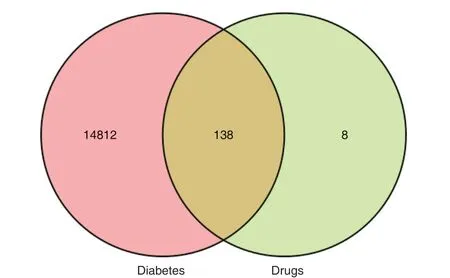
Figure 1. Venn Diagram of the Target Points of Radix Pseudostellariae-Rhizoma Anemarrhenae and DM
PPI Network and Core Components, Target Screening
Cytoscape 3.7.2 software was used to construct a Chinese medicine-active component-target visual network model for the treatment of DM withRadix Pseudostellariae-Rhizoma Anemarrhenae. As shown in Figure 2, there are a total of 153 nodes and 265 lines. Among them, the rhombus represents the Chinese medicine, the circle represents the active ingredient, the square represents the target point,the green represents theRadix Pseudostellariaeand its active ingredient, yellow representsRhizoma Anemarrhenaeand its active ingredient, and blue represents all targets. According to the analysis of network topology parameters, it can be seen that the larger the degree value, the larger the node, and the target with large degree value and intermediate value plays a key role in the network. There are 5 key components with node degree value> mean value (30.153 8), namely luteolin, kaempferol,Anhydroicaritin, acacetin and beta-sitosterol. There are 37 core targets node degree value> mean value(2.840 6) and median value> mean value (0.004 6),including PTGS1, PTGS2, AR, PRSS1, CHRM1,etc.. See Tables 1 and 2 for details.
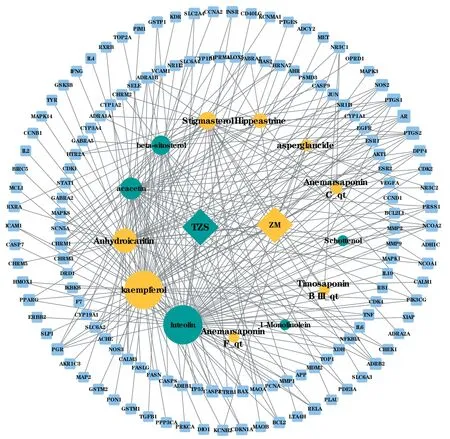
Figure 2. Radix Pseudostellariae-Rhizoma Anemarrhenae for the Treatment of DM Chinese Medicine-active Ingredients-potential Target Network

Table 1. Information on the Key Ingredients of Radix Pseudostellariae-Rhizoma Anemarrhenae in the Treatment of DM
GO Enrichment Analysis
TakingP<0.01 and FDR<0.01 as the conditions, it was screened and obtained that BP is mainly associated with response to organic substance, cellular response to chemical stimulus,response to chemical, response to organic cyclic compound, and response to oxygen-containing compound, etc.. MF is mainly related with enzyme binding, identical protein binding, nuclear receptor activity, transcription factor activity, direct ligand regulated sequence-specific DNA binding, steroid hormone receptor activity, etc.. CC is mainly related to membrane raft, membrane microdomain,membrane region, whole membrane, plasma membrane raft and so on. GO enrichment results were ranked according to the P value in increasing order, and the first 20 GO entries were selected to draw a bubble chart, as shown in Figures 3, 4 and 5.

Table 2. Core Target Information of Radix Pseudostellariae-Rhizoma Anemarrhenae Treatment for DM
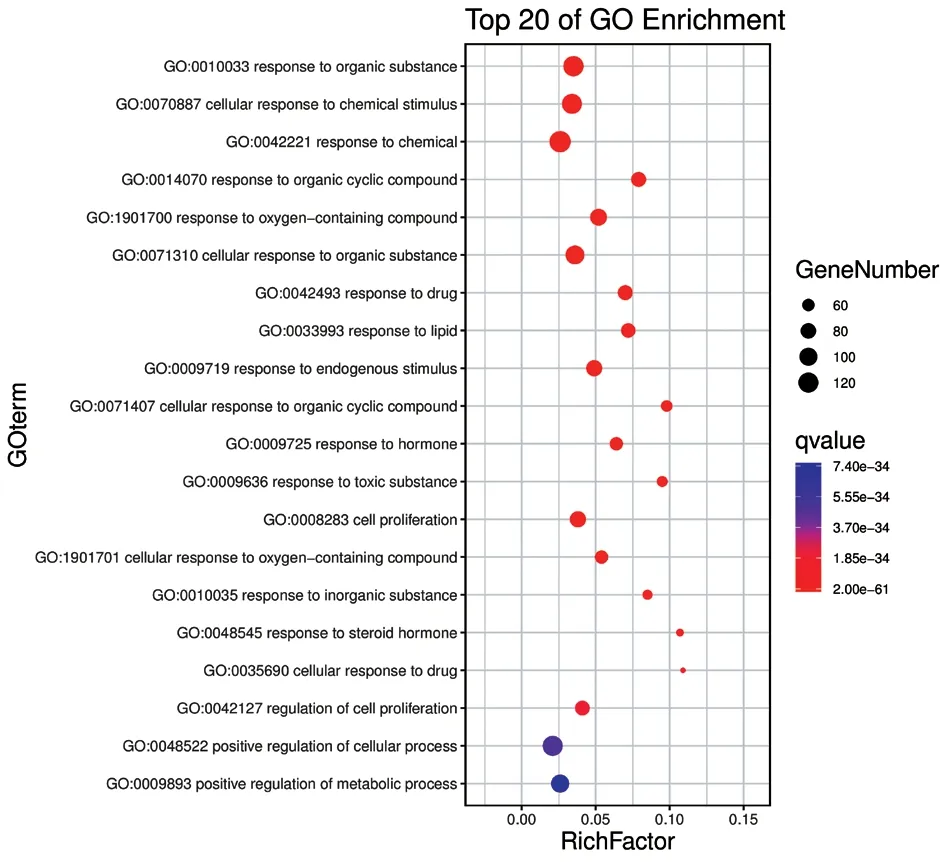
Figure 3. Bubble Diagram of the GO Biological Process Enrichment in Radix Pseudostellariae-Rhizoma Anemarrhenae's Treatment of DM
KEGG Pathway Enrichment
The KEGG pathways related to DM were screened under the conditions ofP<0.01 and FDR<0.05. The enrichment results showed that it was mainly closely related with 7 pathways, i.e. the TNF signaling pathway, Toll-like receptor signaling pathway, NOD-like receptor signaling pathway,Insulin resistance, Type II diabetes mellitus,Adipocytokine signaling pathway, Insulin signaling pathway, as shown in Table 3. The targets enriched on the pathway and corresponding active ingredients are shown in Figure 6. The enrichment of targets on the type II diabetes pathway is shown in Figure 7,and the targets marked with a red star are potential targets.
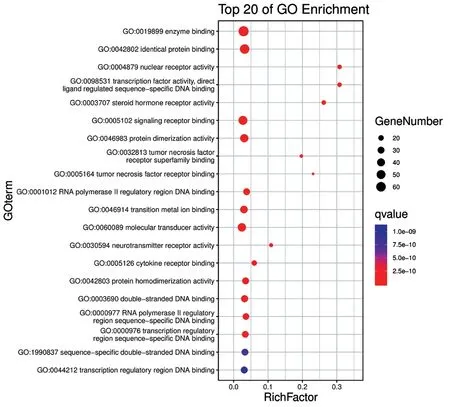
Figure 4. Bubble Diagram of GO Molecular Function Enrichment in Radix Pseudostellariae-Rhizoma Anemarrhenae's Treatment of DM
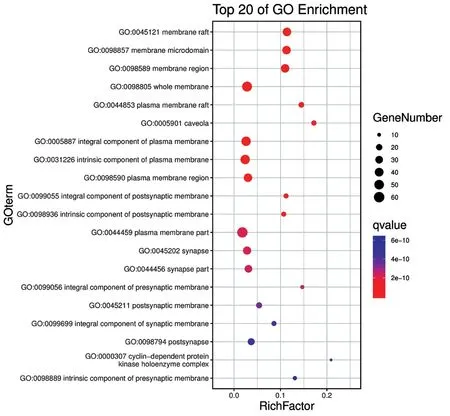
Figure 5. Bubble Diagram of the GO Cellular Composition Enrichment in Radix Pseudostellariae-Rhizoma Anemarrhenae's Treatment of DM
DISCUSSION
Diabetes is a long-term metabolic disorder caused by a combination of genetic and environmental factors. The main pathological change is insulin secretion defect or insulin action defect. Among them, T2DM that accounts for the highest proportion, has insulin resistance (IR) and abnormal pancreatic β cell function[10]. Studies have also shown that inflammation[11]and oxidativestress[12]play important roles in the occurrence and development of T2DM. Hyperglycemia can upregulate chronic inflammation markers and lead to increased ROS production, while oxidative stress and inflammation can lead to insulin resistance and damaged insulin secretion, which eventually triggers and exacerbates T2DM[13]. At present, the treatment of T2DM is mainly based on western medicine, but its therapeutic effect is limited while with many adverse reactions, and its effect on the complications of T2DM is limited[14].TCM treatment of T2DM has the characteristics of multi-channel multi-target regulation. It can correct glycolipid metabolism disorders by protecting β cells, promoting insulin secretion, improving insulin sensitivity[15], regulating the structure of intestinal microbiota and improving immune system function[16]. In theThree Consumption Theory(《三消论》), LIU He-jian believed that consumption thirst was classified as "excessive heat and dryness", and"for consumption in the lower, middle and upper,they are all caused by dryness and heat." He also proposed that the treatment should be "tonifying the coldness and deficiency of kidney Yin, purging the heart fire and excessive Yang-heat, removing excessive dryness and heat in the stomach and intestines, and promoting the declination of body fluid of the whole body." Modern studies have shown that inflammation and oxidative stress are closely related to the "heat syndrome" in TCM[17],
and inflammation may be the material basis of the"heat syndrome"[18].Radix Pseudostellariaehas the effect of replenishing Qi and fortifying the spleen,promoting body fluid generation, and moistening the lung, andRhizoma Anemarrhenaehas the effect of clearing heat and purging fire, nourishing Yin and moisturizing dryness, which make them the choice to nourish Yin and promote fluid generation. The combination of the two medicines could have the effect of replenishing Qi and nurturing Yin, clearing heat and moistening dryness, which is consistent with the basic research reports that the extract ofRadix PseudostellariaeandRhizoma Anemarrhenaesapogenin have good anti-inflammatory and antioxidant effects[20,21].
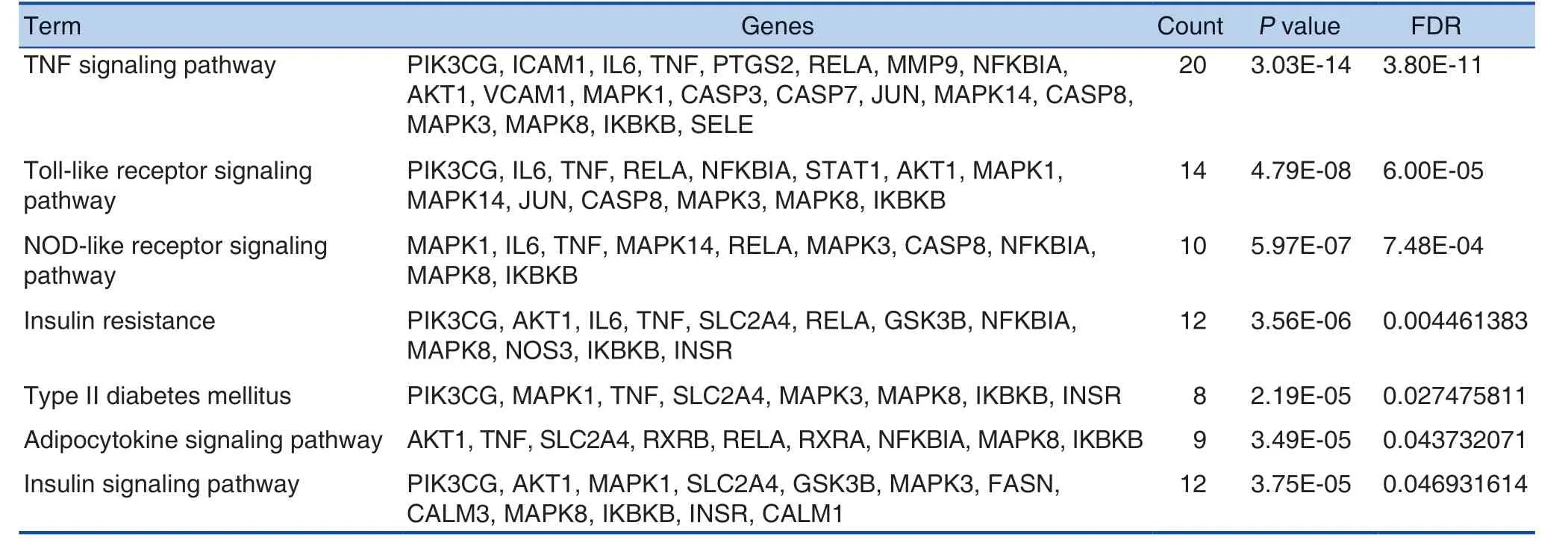
Table 3. The KEGG Signaling Pathway Enriched in the Treatment of DM Targets by Radix Pseudostellariae-Rhizoma Anemarrhenae
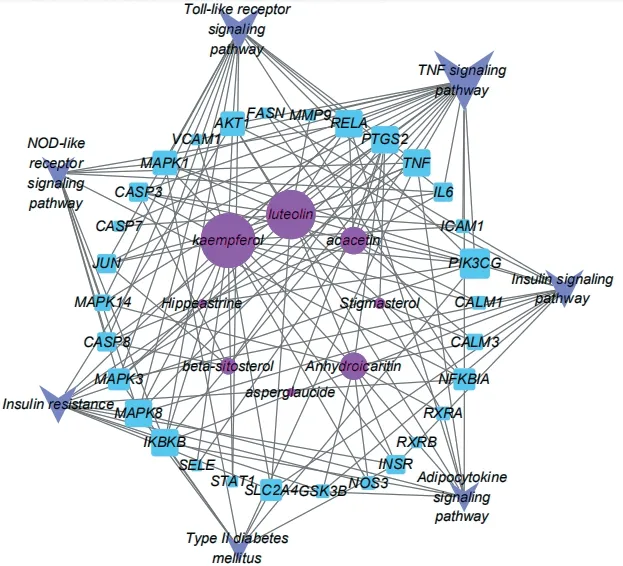
Figure 6. The Active Ingredient-target-KEGG Signaling Pathway Network of Radix Pseudostellariae-Rhizoma Anemarrhenae's Treatment of DM
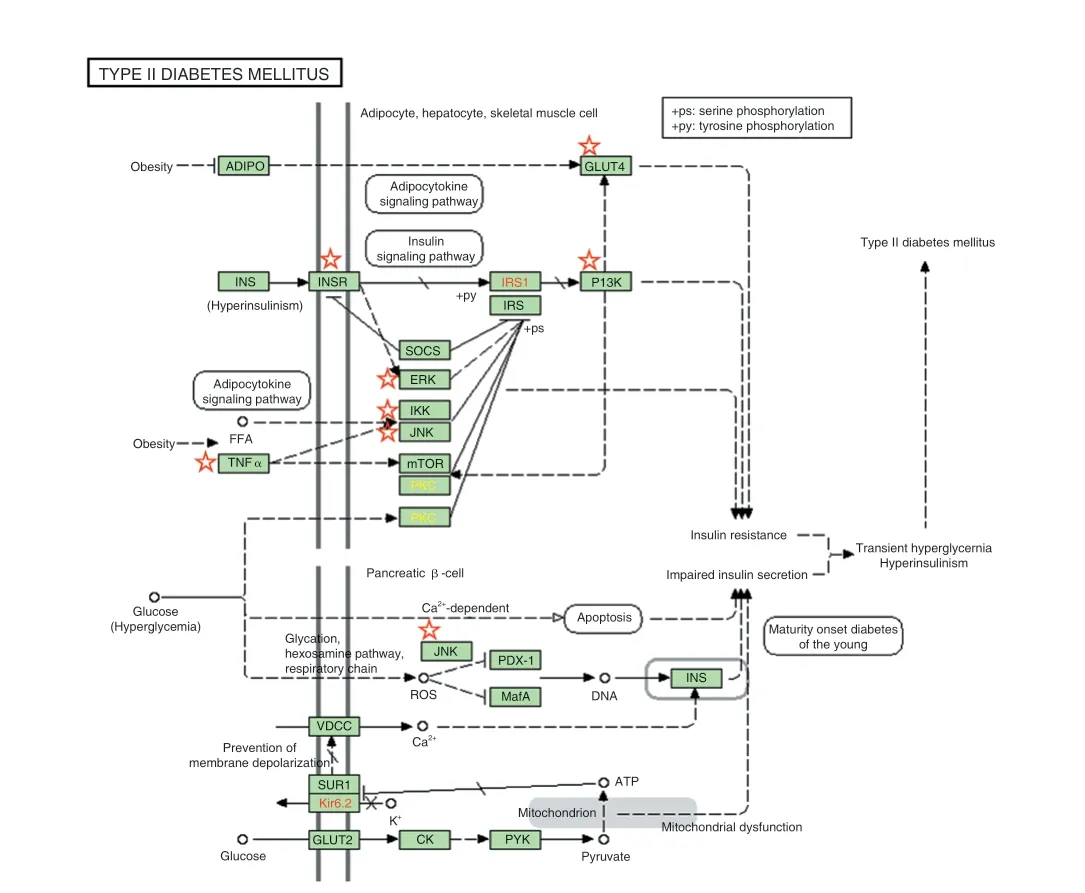
Figure 7. Enrichment Map of Potential Targets in Type II Diabetes Pathways for Radix Pseudostellariae-Rhizoma Anemarrhenae's Treatment of DM
This study screened out a total of 23 active ingredients and 146 potential targets fromRadix Pseudostellariae-Rhizoma Anemarrhenaeof which 138 targets are overlapped with DM. There are 5 active ingredients ofRadix Pseudostellariaeacting on these 138 potential targets, and 8 active ingredients ofRhizoma Anemarrhenaeacting on 138 potential targets. As shown in the network diagram of "Medicine-Active Ingredients-Targets",according to the analysis of the network topology parameters, five key components are obtained,respectively luteolin (Radix Pseudostellariae),Kaempferol (Rhizoma Anemarrhenae), and Anhydroicaritin (Rhizoma Anemarrhenae), acacetin(Radix Pseudostellariae) and β-sitosterol (Radix Pseudostellariae). 37 core targets are obtained,including PTGS1, PTGS2, AR, PRSS1, CHRM1,etc.. Studies have found that luteolin has antioxidant and anti-inflammatory effects. It can protect the heart tissue of STZ-induced diabetic mice by regulating Nrf2-mediated oxidative stress and NF-κBmediated inflammation. Besides, luteolin could also improve neuronal damage and cognitive ability in diabetic rats through reducing oxidative stress and ChE activity[22,23]. Ambasta et al.[24]provided a comprehensive overview of luteolin as a cancer/diabetes therapeutic molecule by acting on a variety of signal cascades (such as p53, Wnt, eNOS, iNOS,SOD, MMP9 and CDK, etc.), and concluded that Luteolin can become a molecule for the treatment of cancer and diabetes by acting on a wide range of signal pathways. Kaempferol has anti-inflammatory and anti-apoptotic effects. Studies have reported that kaempferol can restore the hexokinase activity of the liver and skeletal muscle of diabetic mice, while it also inhibits hepatic pyruvate carboxylase activity and gluconeogenesis to exert anti-diabetic effects.Kaempferol can also improve cAMP/PKA and PI3K/Akt signaling pathways to protect β cells from glucose toxicity and increase cell viability, inhibit cell apoptosis and reduce the activity of caspase-3 to achieve the effect of anti-DM[25-27]. Anhydroicaritin can reduce the blood glucose level of STZ-induced DM mouse model, reduce insulin resistance, and can also inhibit the formation of osteoclasts to improve bone loss caused by diabetes[28]. Acacetin can promote glucose transporter 4 (GLUT4)translocation by activating the CaMKII-AMPK pathway, activate AMPK to inhibit the accumulation of intracellular lipids, and thereby increasing the uptake of glucose by skeletal muscle cells[29]. β-sitosterol can normalize the changes in blood glucose, serum insulin and testosterone, blood lipid profile, oxidative stress markers, and antioxidant enzymes in DM rats, reduce IR, and increase insulin levels[30,31]. In summary, most of the main active ingredients ofRadix Pseudostellariae-Rhizoma Anemarrhenaehave anti-inflammatory, antioxidant, anti-apoptotic,and hypoglycemic functions, which shows thatRadix Pseudostellariae-Rhizoma Anemarrhenaehas the characteristics of multiple components and multiple targets in the treatment of DM.
GO biological process enrichment is mainly related to response to organic substance, cellular response to chemical stimulus, response to chemical, response to organic cyclic compound,and response to oxygen-containing compound,etc.. Molecular functions are mainly related with enzyme binding, identical protein binding, nuclear receptor activity, transcription factor activity,direct ligand regulated sequence-specific DNA binding, steroid hormone receptor activity, etc..Cell composition is mainly related to membrane raft, membrane microdomain, membrane region,whole membrane, plasma membrane raft and so on. KEGG pathway enrichment results show that the targets are mainly enriched in the TNF signaling pathway, Toll-like receptor signaling pathway, NODlike receptor signaling pathway, Insulin resistance,Type II diabetes mellitus, Adipocytokine signaling pathway and Insulin signaling pathway. There are 8 potential targets enriched in the T2DM pathway,namely PIK3CG, MAPK1, TNF, SLC2A4, MAPK3,MAPK8, IKBKB and INSR. Patients with DM are in a state of high glucose for a long time, which will trigger inflammation and oxidative stress response activation in various tissues of the body. Inflammatory cytokines such as TNF-α, TGF-α, IL-1,IL-6 induce a large amount of ROS production,and excessive ROS can activate NF-κB and its downstream signal pathways through the MAPK pathway, release a large number of inflammatory factors, and then lead to pancreatic islet cell apoptosis[32]. Toll-like receptors and NOD-like receptors can induce the body to produce a large number of inflammatory factors and activate immune inflammation response, leading to insulin resistance,islet cell inflammatory response and islet β cell dysfunction in T2DM patients[33-35]. In addition, a series of adipocytokines released by adipose tissue can affect the body's metabolic activities and induce insulin resistance[36,37].
In summary, the effective ingredients ofRadix Pseudostellariae-Rhizoma Anemarrhenaein the treatment of DM may be luteolin, kaempferol, and Anhydroicaritin, acacetin and β-sitosterol, etc..These ingredients act on PTGS1, PTGS2, AR,PRSS1, CHRM1 and other targets, by regulating TNF, Toll-like receptors, NOD-like receptors, insulin resistance, type II diabetes, adipocytokine signaling pathways and insulin signaling pathways, they have anti-inflammatory, antioxidant and hypoglycemic effect, and improved Insulin resistance, and then play its role in the treatment of DM. However, this article only explains from the perspective of theory and network prediction, and experiments are still needed to verify the core components, targets and pathways in order to provide theoretical and experimental basis for drug development.
